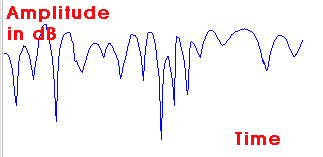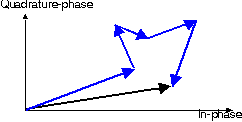
 | JPL's Wireless Communication Reference Website
Chapter: Wireless Channels |

|
A sample of a Rayleigh fading signal.
Signal amplitude (in dB) versus time for an antenna moving at constant velocity.
Notice the deep fades that occur occasionally. Although fading is a random process, deep fades have a tendency to occur approximately every half a wavelength of motion.
See also: |
Next we'll discuss the basic mechanisms of mobile reception.

The Doppler shift of this wave is
![]() ,
,
where v is the speed of the antenna.
Phasor representation

Figure: Phasor diagram of a set of scattered waves (in blue),
resulting a Rayleigh-fading envelope (in black).
Animation.
In case of an unmodulated carrier, the transmitted signal has the form
![]() .
.
The received unmodulated signal r(t) can be expressed as
![]()
An inphase-quadrature representation of the form
![]()
can be found with in-phase component
![]()
and quadrature phase component
![]() .
.
![]()
and
![]()
Thus both the inphase and quadrature component, I(t) and Q(t) can be interpreted as the sum of many (independent) small contributions. Each contribution is due to a particular reflection, with its own amplitude cn and phase. For sufficiently many reflections (large N), the Central Limit Theorem now says that the inphase and quadrature components tend to a Gaussian distribution of their amplitude. I(t) and Q(t) appear to be independent and identically distributed (iid).
Note also that if the antenna speed is set to zero, channel fluctuations no longer occur. Fading is due to motion of the antenna. An exception occurs if reflecting objects move. In a vehicular cellular phone system, the user is likely to move out of a fade, but in a Wireless LAN, a terminal may by accident be placed permanently in a fade where no reliable coverage is available.
| Parameter | Probability Distribution | |
| I(t1) and Q(t1) components | i.i.d. Gaussian, Zero mean | |
| I(t1) and Q(t2) components at time offset | Correlated jointly Gaussian | |
| I(t2) given I(t1) | Gaussian | |
| Amplitude r | Rayleigh | |
| r(t2) given r(t1) | Rician | |
| Derivative of Amplitude | Gaussian Independent of amplitude | |
| Phase | Uniform | |
| Derivative of Phase |
Gaussian Dependent on amplitude | |
| Power | exponential |
This propagation model allows us, for instance,
If the set of reflected waves are dominated by one strong component, Rician fading is a more appropriate model.